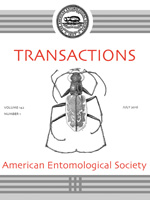Discriminate analysis and canonical correlation analysis were used to separate the Aphaenogaster phalangium species complex into 5 species of tropical New World ants: A. araneoides Emery, A. brevicollis Forel, A. inermis Forel (=Aphaenogaster araneoides var. nitidiventris new synonymy), Aphaenogaster (Deromyrma) araneoides var. canalis new synonymy), A. mexicana (Pergande) and A. phalangium Emery. This complex is easily recognized as a long necked group of Aphaenogaster found primarily in tropical forests. Aphaenogaster araneoides, distributed from El Salvador to Panama, can be recognized by the relatively elongated neck, lack of erect hairs on the dorsum of the posterior femur, and in that the sculpture of the head is similar to that of the dorsum of the first tergum of the gaster. Aphaenogaster brevicollis, known only from northern Panamá, is a robust, relatively large species with a short neck. Aphaenogaster inermis is a smaller species found from Nicaragua south into Colombia, with numerous semierect hairs on the dorsum of the hind femur, the only species with this characteristic. Aphaenogaster mexicana is known only from central western México, and is a weakly sculptured species with a small eye and moderately developed propodeal spines. Finally, A. phalangium is similar to A. araneoides, except that the dorsum of the first gastral tergum is finely sculptured, much more weakly than the sculpture of the dorsum of the head, and is known from El Salvador to NW Colombia. The workers and males are separated by keys in English and Spanish, the characteristics and distributions of each species are discussed.
How to translate text using browser tools
4 March 2016
A Revision of the phalangium Species Complex of the Ant Genus Aphaenogaster (Hymenoptera: Formicidae: Myrmicinae)
William Mackay,
Shawn T. Dash
ACCESS THE FULL ARTICLE
análisis de correlación canónica
análisis discriminante
ants
Aphaenogaster
Canonical correlation analysis
discriminant analysis
Formicidae





